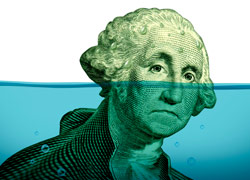“Things that make you go hmmm”, analysts doubt OPEC’s cut will last…
The ink wasn’t even dry on the agreement that OPEC (apparently) signed on November 30th and analysts scratched their heads, stroked their beards, narrowed their eyes, sharpened their pencils and began to cast their collective cynical gaze over the numbers. Quite simply; the numbers don’t add up, they don’t crunch and the suspicion is that the cartel’s agreement will be broken sooner, rather than later.
First the glaring miscalculation; the total production agreement, of 32.68m barrels a day, is almost 200,000 b/d higher than the new target.
Secondly; although Indonesia is suspended from OPEC, the country’s production of about 720,000 b/d is included in the new production ceiling of 32.5m b/d. So too is output from Nigeria and Libya, two countries who are exempt. So three countries are exempt, but the supply target includes them. It’s almost certain that these countries will continue to increase production.
Then there’s the issue of Saudi Arabia, who will be shouldering half of the OPEC production cuts. Lastly, Russia, the second largest energy supplier on planet earth, is loosely committing to cuts, but as non OPEC members they’re at liberty to alter their supply to fit their own needs, not OPEC’s.
It’d be a brave investor or trader who decided to call “the top of oil” at circa $50 a barrel and short the market, so soon after the agreement was reached. But many analysts are suspecting that, once the figures and hard data begin to be revealed to the market, we’ll discover that the the production cuts will be breached and the glut of supply will begin to (once again) build up.
Equity markets in the USA recently printed highs, several days in succession. This apparent risk on environment has caused many to ignore a seismic shift in another market that hasn’t hit the mainstream media’s radar, perhaps because it hasn’t chimed with the “good times” narrative. The bond market has lost circa $1.7 trillion in a single month, the 30-year-old bull market in bonds finally looks as if it’s ending, with a bang.
The S&P 500 Index fell 0.4 percent to 2,191.08 during Thursday’s trading sessions, falling for the third time in four days after ending last week at a record high. The DJIA (Dow Jones Industrial Average) rose 0.4 percent. Tech shares in the Nasdaq Composite Index were down 1.4 percent, as investors have rotated out of an investment sector previously favoured for the majority of the year.
European markets sold off; the U.K. FTSE closed down 0.45%, Germany’s DAX down 1% and France’s CAC closed down 0.39%. STOXX 50 finished the day down 0.68%.
Gold has suffered its worst month in three years, dropping by circa 7.8 percent in November, on the basis that the USA Fed is expected to raise base rates by 0.25% when the FOMC meets later this month, therefore gold has lost its safe haven appeal. Gold futures for February delivery fell 0.4 percent to $1,169.40 an ounce at midday Thursday on the Comex in New York, before recovering to $117.40 later in the session. The metal fell below $1,200 last week, for the first time since February.
Naturally oil linked currencies were the biggest gainers on the FX market on Thursday, coming after the OPEC agreement saw oil explode to the upside, with WTI at once point flirting with $52 a barrel. Russia’s ruble and Norway’s krone were two of the biggest oil producer currency gains. However, the Colombian peso was the winner, gaining two percent on the day.
In terms of the major currencies the (highly sensitive to Brexit news) UK pound enjoyed a day of solid gains, as a consequence of the U.K. Minister David Davis back peddling on the UK’s negotiating stance. The reverse gear wasn’t just engaged, he managed to find record reverse speeds and conduct a handbrake U-turn, as he intimated that the U.K. would in fact be prepared to pay for single European market access and would agree to the free movement of European people. The pound as a consequence climbed by 0.5 percent to reach $1.258 as of 5 PM London time, having reached its highest level since Oct. 6th. It’s still down circa sixteen percent since the EU referendum vote in late June. Sterling appreciated by 0.2 percent to reach 84.52 pence per euro.
Economic calendar high impact events that could affect markets on 02/12/2016
By far the most dominant high impact news event is non farm payrolls, commonly referred to as “NFP day”. However, there’s a slew of other key data releases on Friday, that have the capacity to shock and move currency markets, depending on the data print. We start with Swiss data.
6.45 London time. CHF Gross Domestic Product (YoY) (3Q). The prediction is for a fall from GDP of 2% annually to 1.8%. Naturally, the value of the Swissie, versus principally the euro and USA dollar, could be hit if the figure differs from this polled analyst estimate.
9.30 London time. GBP Markit/CIPS UK Construction PMI (NOV). Construction sentiment has taken quite a hit since the U.K. referendum decision, however, many large scale projects were already agreed and in the pipeline to be delivered. Analysts will now be looking to see if the UK’s construction momentum has been hit, due to projects being either mothballed, or cancelled. And critically Markit data is looked upon as a leading indicator, not lagging. Analysts polled expect a figure of 52.2 to be released, falling from 52.6 the previous month. Above or below this figure, may cause sterling to react.
13.30 London time. USD Unemployment Rate (NOV). The rate is expected in at 4.9%, remaining static from the previous month.
13.30 London time. USD Change in Non-farm Payrolls (NOV). The expected print is 180K jobs created in the month of November. There are seasonal factors in play; firms may be gearing up to fulfil Xmas orders, they may be taking on extra staff, the final NFP print before Xmas can often surprise, naturally any deviation from the polled figure could cause a reaction in the USD versus many of its peers.
13.30 London time. CAD Unemployment Rate (NOV). Canada’s unemployment rate is expected to remain steady at 7%. Should the number printed be significantly different then the Canadian dollar’s value may be impacted.

